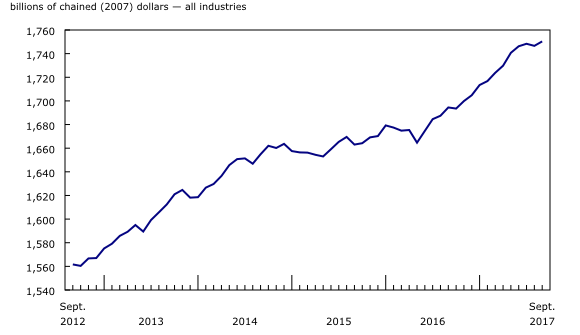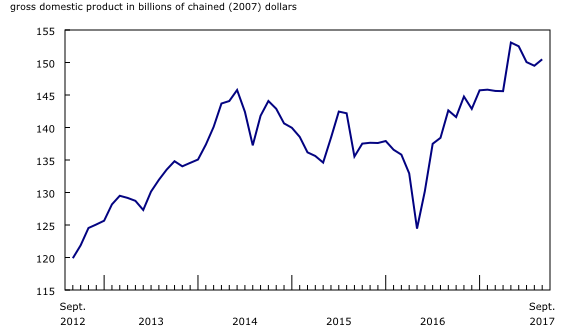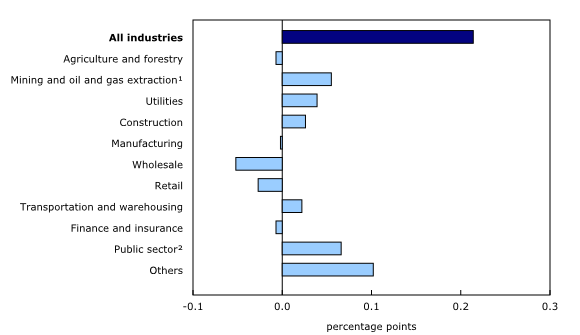Gross domestic product by industry, September 2017
Archived Content
Information identified as archived is provided for reference, research or recordkeeping purposes. It is not subject to the Government of Canada Web Standards and has not been altered or updated since it was archived. Please "contact us" to request a format other than those available.
Released: 2017-12-01
September 2017
0.2% 
(monthly change)
Real gross domestic product (GDP) rose 0.2% in September after edging down 0.1% in August. Goods-producing (+0.4%) and services-producing (+0.1%) industries rose as 12 of 20 industrial sectors grew, led by the mining, quarrying and oil and gas extraction sector.
The mining, quarrying and oil and gas extraction sector expands
The mining, quarrying and oil and gas extraction sector was up 0.7% in September after declining for three consecutive months.
The oil and gas extraction subsector rose 1.0% after declining in each of the three previous months. Conventional oil and gas extraction was up 3.4%, led by increased natural gas extraction. Crude petroleum production was also up after declining in August, which was partly due to scheduled maintenance shutdowns in Newfoundland and Labrador. Non-conventional oil extraction declined 1.6%, the third decrease in four months.
For the sixth month in a row, the mining and quarrying (except oil and gas) subsector expanded, rising 0.4% in September. Metal ore mining (+1.6%) grew for the third consecutive month, led by increases in iron ore (+10.2%) and gold and silver mining (+4.7%). Partly offsetting the growth were declines in copper, nickel, lead and zinc mining (-2.4%) and other metal ore mining (-4.0%).
The 1.2% decline in non-metallic mineral mining in September did not offset August's growth. Other non-metallic mineral mining was down 1.6% due to lower activity in the mining of potash and other non-metallic minerals.
Real estate and rental and leasing up
Real estate and rental and leasing rose 0.4% in September. Activity at the offices of real estate agents and brokers increased for the second month in a row, up 3.5% in September, led by increased home resale activity in Ontario and British Columbia. The level of activity of this subsector has not returned to the level registered in March, following changes in provincial housing regulations in Ontario in April.
This increase influenced the 0.6% rise in professional services, as it contributed to a 2.4% increase in legal services.
Utilities up from volatile September weather
Utilities increased 1.7% in September as volatile and unseasonal weather conditions increased the demand for air conditioning and heating across many parts of the country. Electric power generation, transmission and distribution grew 1.5%, while natural gas distribution increased 4.4% with higher demand from all sectors.
Construction grows
The construction sector rose for the fourth consecutive month, up 0.4% in September. Except for a decline in May due in part to a strike affecting unionized construction workers in Quebec, this sector has been up every month since November 2016.
Residential construction was up 1.0% in September as single, double and row dwelling unit construction grew, along with home alterations and improvements. Repair construction increased 1.5%, the largest increase since November 2016, in part as a reflection of favourable weather conditions. Engineering and other construction activities declined 0.6% while non-residential construction contracted 0.3% as a result of lower industrial and public construction.
Transportation and warehousing grows
Transportation and warehousing grew 0.5% as six of nine subsectors increased. Rail transportation was up 4.4% as movement of coal, grain and fertilizer, intermodal and other freight by rail increased. Pipeline transportation expanded 1.3%, as crude oil and other pipeline transportation rose 2.6% while pipeline transportation of natural gas edged down 0.1%. After three consecutive increases, air transportation was down 0.4% in September.
Wholesale and retail trade decline
Following eight increases in nine months, wholesale trade declined 0.9% in September with decreases in seven of nine subsectors. The 6.7% decline in personal and household goods wholesaling more than offset the increases of the previous two months. A 1.3% drop in miscellaneous wholesaling was widespread across the various industries. Food, beverage and tobacco wholesaling (-0.8%) declined for the third time in four months. Activity at building materials and supplies wholesalers was up 2.9%, essentially offsetting the decline in August.
Retail trade was down for the third month in a row, falling 0.5% in September as 9 of 12 subsectors were down. Declines were most notable at clothing and clothing accessories stores (-1.8%), gasoline stations (-2.4%) and motor vehicle and parts dealers (-0.9%). Conversely, sales were up at building material and garden equipment and supplies dealers (+2.1%) and furniture and home furnishings (+2.0%). The unseasonal weather patterns affecting utilities reduced seasonal demand for clothing while favouring higher activity related to construction and home renovation.
Manufacturing is unchanged
Manufacturing was essentially unchanged, as growth in non-durable (+0.4%) was offset by a decline in durable (-0.4%) manufacturing.
In non-durable industries, the growth came mainly from a 4.0% rise in petroleum and coal products after two months of declines. In durable industries, the decline came mainly from a 2.4% decrease in primary metals which was widespread across its industries.
Other industries
The public sector was up 0.3%, with all three components (education, health care and public administration) showing increases.
Accommodation and food services rose 0.9%, with both accommodation services and food services and drinking places showing increases.
Finance and insurance edged down 0.1% in September. Depository credit intermediation and monetary authorities, as well as insurance carriers and brokers, were down while financial investment services, funds and other financial vehicles were essentially unchanged.
Agriculture, forestry, fishing and hunting (-0.5%) was down for the 9th time in 12 months.
Third quarter of 2017
The value added of goods-producing industries increased 0.4% in the third quarter, up for the fifth consecutive quarter, while that of services-producing industries rose 0.6% as 10 of its 15 industrial sectors increased.
The main contributor to the growth in the goods-producing industries was the construction sector (+1.3%), which grew for the fourth consecutive quarter. All subsectors registered growth, with the 2.8% rise in non-residential construction coming after seven consecutive quarterly declines.
Utilities were up 2.9% on the strength of a 3.8% rise in electric power generation, transmission and distribution. Mining, quarrying, and oil and gas extraction was down 0.2% as oil and gas extraction was essentially unchanged, while mining except oil and gas extraction increased but was more than offset by declines in support activities for mining and oil and gas extraction. Manufacturing was down 0.1%, mainly due to declines in transportation equipment manufacturing. Agriculture, forestry, fishing and hunting decreased 0.9%.
Growth in the services-producing industries was led by the fourth consecutive quarterly increase in wholesale trade (+2.0%) as all subsectors grew.
The public sector (education, health care and public administration) rose 0.9% with all components contributing to the growth. It was the 13th consecutive quarterly growth of the sector since the third quarter of 2014.
There were notable increases in professional, scientific and technical services (+0.9%) and transportation and warehousing (+0.6%). Real estate and rental and leasing rose 0.3%, but activity at real estate agents and brokers was down 5.6%, the fourth decline in the last five quarters. Retail trade (-0.1%) edged down following four consecutive quarters of growth, while finance and insurance was essentially unchanged after having grown for eight quarters in a row.

In celebration of the country's 150th birthday, Statistics Canada is presenting snapshots from our rich statistical history.
On September 11, 2001, events in the United States resulted in American and Canadian federal authorities immediately closing airspaces of the two countries and ordering the emergency landing of all flights when it became evident that airplanes were used as tools to carry out attacks. Hundreds of international flights headed for the United States were diverted to various Canadian airports, many of them landing in places not used to seeing large volume of traffic such as Goose Bay, Gander and Stephenville in Newfoundland and Labrador, and Whitehorse in Yukon, under the escort of Canadian Air Forces' CF-18 fighter jets. Trying to find temporary lodging for all affected travellers was a logistical challenge. Many smaller Canadian communities lacking lodging capacity to accommodate the influx, such as Gander, opened up their community facilities and even welcomed thousands of stranded passengers into their homes, gaining international attention and praise for gracious hospitality. Canadian airspace was subsequently closed to all traffic, except flights required for humanitarian or military purposes, for four days following the events. On September 11, many government and tourist sites were closed, including Parliament Hill in Ottawa and the CN Tower in Toronto. Some border crossings, such as the Windsor Tunnel and the Ambassador Bridge, were also temporarily closed.
Combined with the general slowdown in the Canadian economy at the time, the events contributed to real gross domestic product (GDP) contracting 0.6% in September 2001, one of the largest monthly declines in the last 35 years outside of the economic downturn at the end of 2008. Real GDP by expenditure declined 0.1% in the third quarter of 2001, which marked the end of the longest string of uninterrupted quarterly economic growth recorded in Canada (41 quarters).
The largest declines in September 2001 were in travel-related sectors. Accommodation services declined 10.6%, the industry's single largest monthly decline ever reported, while air transportation dropped 17.2%, the largest monthly decline in the last 40 years, as travel both by foreigners to Canada and Canadians to points abroad decreased significantly. Other industries were partly affected by the events of September 11, most notably wholesale (-1.9%) and retail (-1.6%) trade. The manufacturing decline of 1.8% in the same month was influenced by border-crossing delays in the aftermath of the attacks, but there were also other factors at play, such as scheduled maintenance shutdowns at a number of petroleum and coal products plants.
The impact of events had an extended impact on the air transportation industry. In the third quarter of 2001, Canada's air transportation subsector's real GDP declined 6.9%, and it took over three years for the industry to climb back to its level of economic activity prior to September 2001.
Sustainable Development Goals
On January 1, 2016, the world officially began implementation of the 2030 Agenda for Sustainable Development—the United Nations' transformative plan of action that addresses urgent global challenges over the next 15 years. The plan is based on 17 specific sustainable development goals.
The release on gross domestic product by industry is an example of how Statistics Canada supports the reporting on the Global Goals for Sustainable Development. This release will be used in helping to measure the following goal:

Note to readers
Monthly gross domestic product (GDP) by industry data at basic prices are chained volume estimates with 2007 as the reference year. This means that data for each industry and each aggregate are obtained from a chained volume index, multiplied by the industry's value added in 2007. Monthly data are benchmarked to annually chained Fisher volume indexes of GDP obtained from the constant-price supply and use tables (SUT) up to the latest SUT year (2014).
For the period starting with January 2015, data are derived by chaining a fixed-weight Laspeyres volume index to the prior period. The fixed weights are 2014 industry prices.
This approach makes the monthly GDP by industry data more comparable with expenditure-based GDP data, which are chained quarterly.
All data in this release are seasonally adjusted. For information on seasonal adjustment, see Seasonally adjusted data – Frequently asked questions.
For more information on GDP, see the video What is Gross Domestic Product (GDP)?
Revisions
With this release of monthly GDP by industry, revisions have been made back to January 2013.
Each month, newly available administrative and survey data from various industries in the economy are integrated and result in statistical revisions. Updated and revised administrative data (including taxation statistics), new information provided by respondents to industry surveys, and standard changes to seasonal adjustment calculations are incorporated with each release.
Real-time CANSIM tables
Real-time CANSIM table 379-8031 will be updated on December 18. For more information, consult the document Real-time CANSIM tables.
Next release
Data on GDP by industry for October will be released on December 22.
Products
For more information about monthly national GDP by industry, see the System of Macroeconomic Accounts module on our website.
The User Guide: Canadian System of Macroeconomic Accounts (13-606-G) is also available.
The Methodological Guide: Canadian System of Macroeconomic Accounts (13-607-X) is also available.
Contact information
For more information, contact us (toll-free 1-800-263-1136; 514-283-8300; STATCAN.infostats-infostats.STATCAN@canada.ca).
To enquire about the concepts, methods or data quality of this release, contact Allan Tomas (613-790-6570), Industry Accounts Division.
- Date modified:




